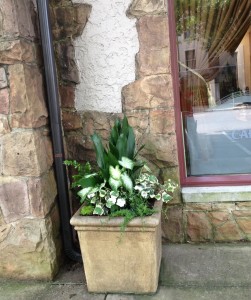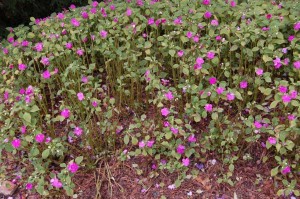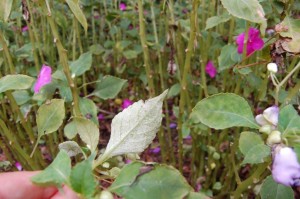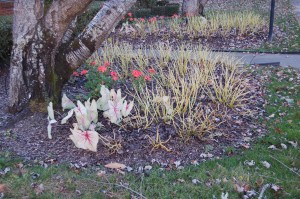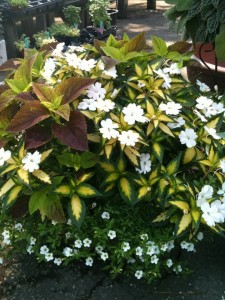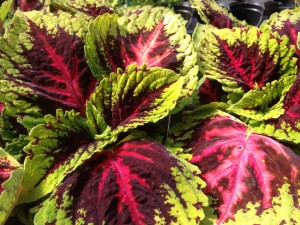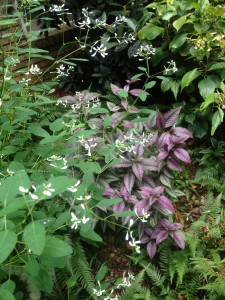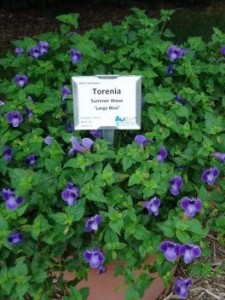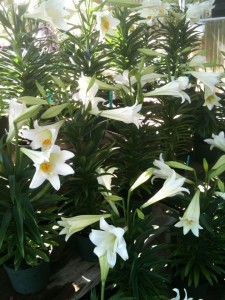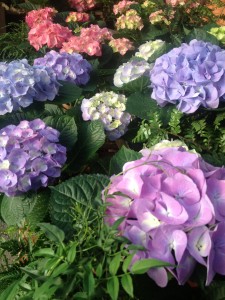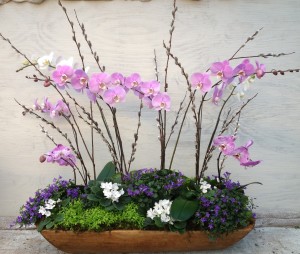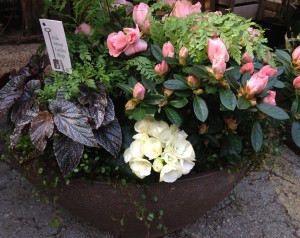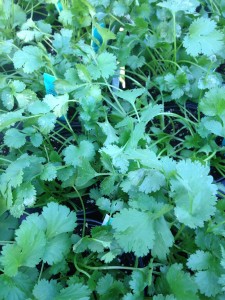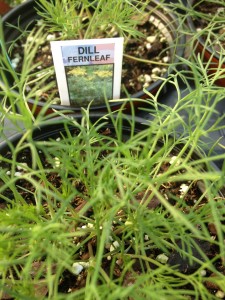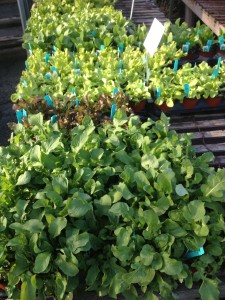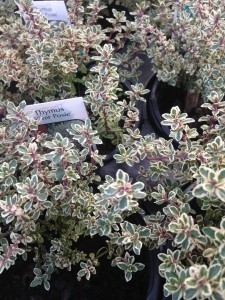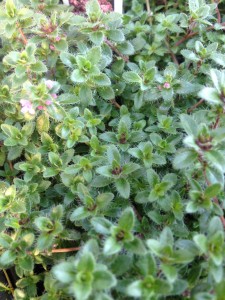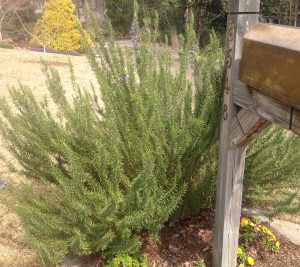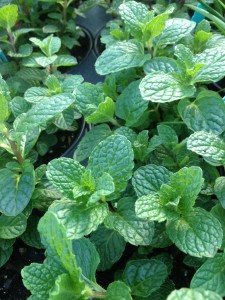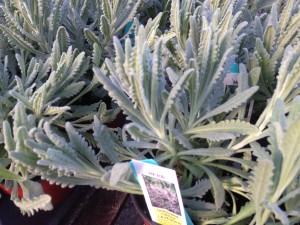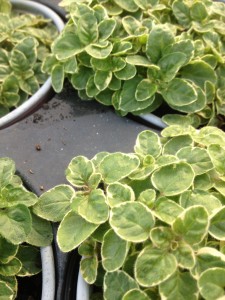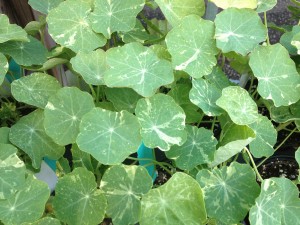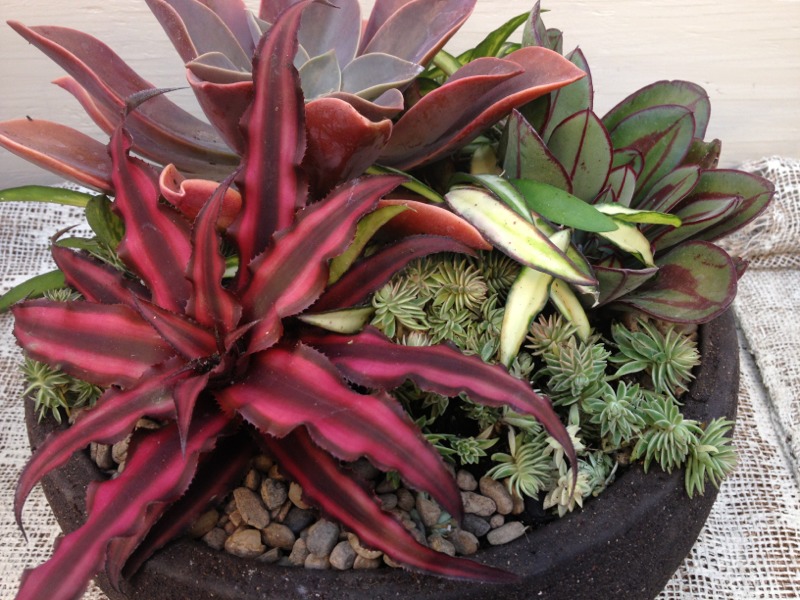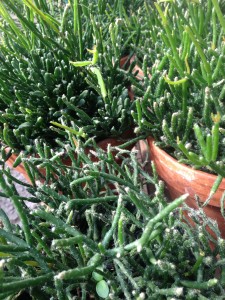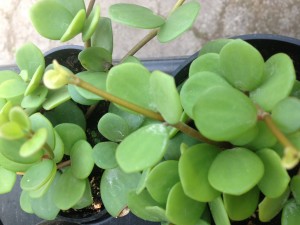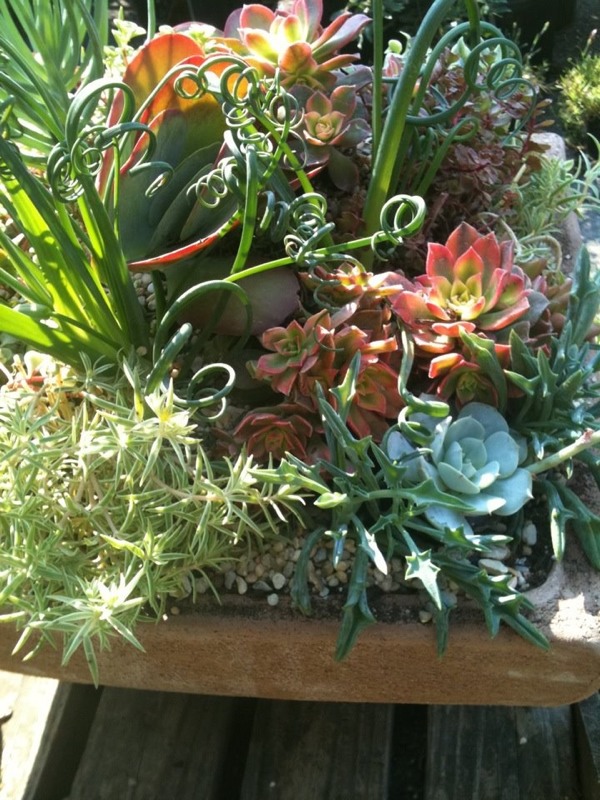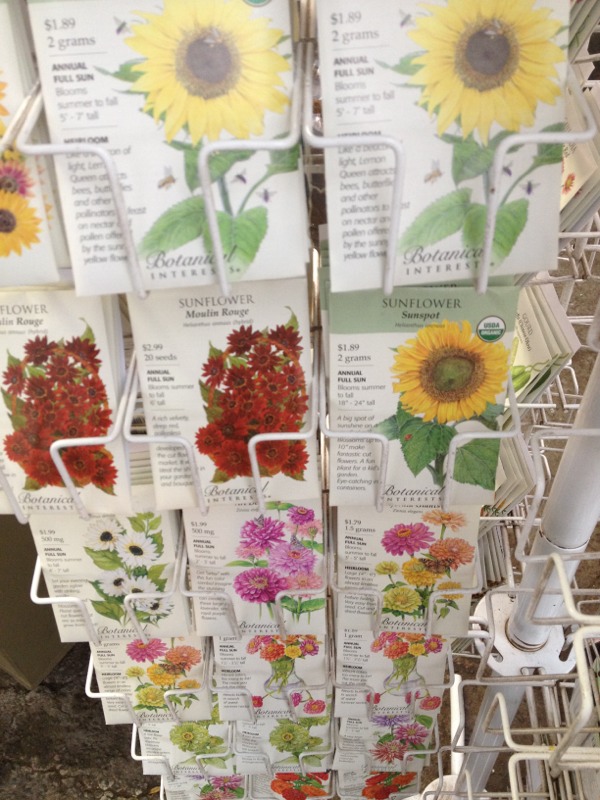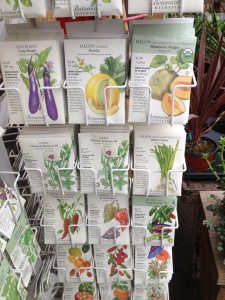Annual…Perennial…It’s okay if you can’t seem to remember which is which – that’s our job! So, for all of you that are perennially (haha) confused and would like to finally get it straight, here’s the scoop:
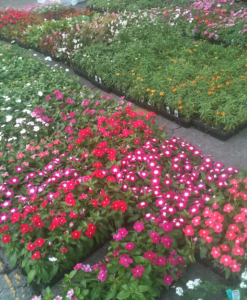
annual bedding plants…
Annual: one of those go-to plants that you put out each year – for example in your planters – (annually) a geranium, or begonia perhaps. Annuals give you a lot of bang for your buck in one fell swoop – but, when they’ve exhausted their blooming period, they are finished, kaput, done. This also applies to fall plants such as pansies and violas. We call them cool season annuals because their blooming period – (before they’re finished, kaput, done,) is the cool season, or winter. Cool season annuals just can’t take the heat, so when they’ve given it up we plant out summer annuals – think zinnias, begonias, caladiums, coleus, fan flower…all the pretty plants we buy in our frenzy of spring fever.
So, maybe that helps a little bit? Put another way, you plant annuals in the Birmingham area annually (each year – spring and fall.) Some annuals for spring/summer planting become available early in the spring and others show up a bit later and really need the heat turned up to do well. Annuals also provide lasting color – useful for the long summer season…typically, annuals in the Birmingham area begin to play out and look “tired” by mid-August though, even with the best of care. August is one tough month!
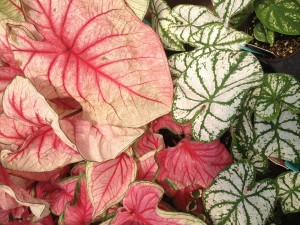
Caladiums…
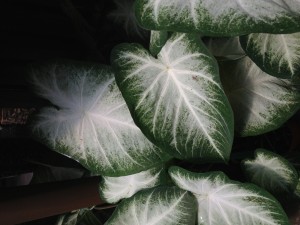
Caladium ‘Aaron’, a great choice for sun or shade
Here’s a small sampling of some great annuals for Birmingham and surrounding areas – this is just the tip of the iceburg, however. For more inspiration, check out our Facebook page too, or better yet, stop in!
Dragonwing begonias – sun or shade, with adequate water they get huge!
Caladiums – traditional shade plant, now many selections are available for sun too. Pretty mixed with asparagus or other ferns, begonias, Sunpatiens, torenia or any other flowering annual that compliments the color of their leaves. They’ll do best if you wait to plant in garden beds until the ground is warm, usually by May.
Coleus – beautiful colors! Another that used to play only in the shade, now many varieties are used in full sun plantings. Very useful as an accent foliage in beds or containers, they can get very large! It’s quite easy to keep them at whatever size you’d like, though. Simply pinch when young or cut them back if they get out of hand! Check the tag for sun tolerance.
Gomphrena – This one may not be familiar to you. A heat lover, it has globes of purple, orange or sometimes pink flowers, and is long lasting and tough. It never looks like much in a pot so you’ll have to trust us on this one – but if you do, you won’t be sorry …and they’ll still look good in August!
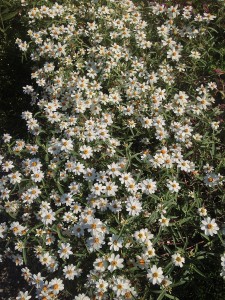
narrow leaf zinnias come in white, yellow, orange and a mix…
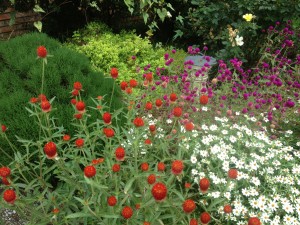
Gomphrena & narrow leaf zinnias in a hot, sunny bed
Zinnias – There are many varieties of zinnia from the tiny flowered narrow leaf zinnia to the more open Profusion and Zahara zinnias, and they all love the heat. Don’t be afraid to cut them back if they become rangy mid-summer. If you do, they’ll also still be looking good in the latter part of the season.
Vinca – this one is the absolute easiest, most fool proof annual to use for a lot of color in hot spots. Plant them and don’t baby them with too much water. They’ll reward you with loads of pretty blooms in clear colors. There’s also a trailing vinca as well. As with caladiums, don’t plant too early in the ground.
Sunpatiens and New Guinea impatiens – these are the types of impatiens that are resistant to downy mildew which is affecting bedding plant and double impatiens in our area. They are only available in larger pots, but you don’t need as many of them since you can space them further apart in your beds. In containers they make quite a show too!
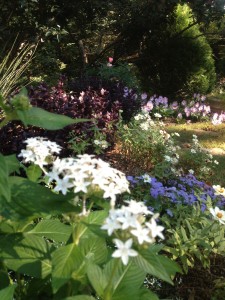
white pentas still looking fresh in this late summer photo
Pentas – the butterflies love pentas and these come in so many colors. Bright red, white, light and dark pink, lilac – there’s a color for everyone! To maintain pentas, you need only keep them deadheaded – keeping the old blooms cut off. If you haven’t tried these, you’re in for a treat!
Lantana – The old stand-by for sun and heat. There are many good selections of lantana now and growth habit varies – some will get enormous, (tall and wide) while others will stay more mounding and compact, so always check the tag for size. Particularly nice for planters are the trailing varieties which come in bright yellow, white and lavender. They take a while to take off, but once the heat sets in they spread like crazy!
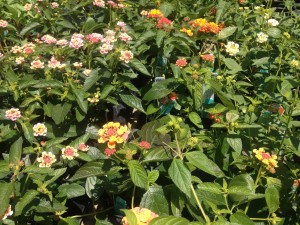
heat loving lantana…
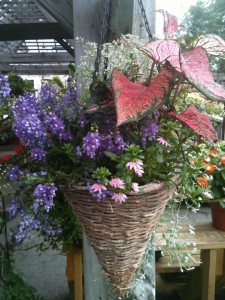
This hanging basket for sun includes a sun loving caladium, angelonia, pink fan flower, trailing silver dichondra, and an airy white euphorbia…
Angelonia – Sometimes called summer snapdragon because of the shape of the bloom, angelonia is a good choice to add some height in beds and containers. Strongly upright in growth, but loose enough to not look stiff, it’s a welcome addition to our summer plant palette. Hybridizers have been working overtime improving color, bloom size and heat tolerance, making these beauties one of the newer go-to plants for summer plantings, adding shades of purple, pink, lilac and white.
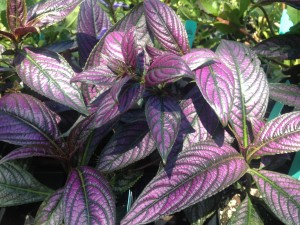
Persian shield…
Strobilanthes/Persian Shield – This foliage plant is an excellent annual, like the caladium, that is useful as a foliage accent in plantings. In the ground or in pots, it is gorgeous!
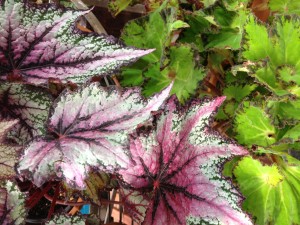
Rex begonias…
Rex Begonias – Another great foliage accent in many leaf patterns. Good for shade planters primarily. Technically a houseplant, but I couldn’t resist putting another foliage option in this post!
We’ll discuss perennials (they’re the ones that come back if they’re in their happy spot.) in a future post. Meantime, maybe there are one or two annuals on this list you haven’t tried – maybe it’s time!
– Posted using BlogPress from my iPhone
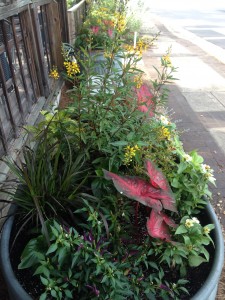
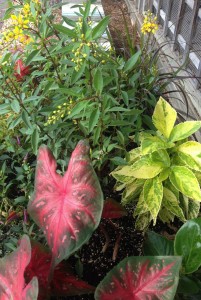 While all caladiums appreciate heat and shade, there are some that can also handle sun, including ‘Red Flash’, the one shown here. These deep red leaves will mingle with the other foliage and flowers, including a copper plant, Acalypha ‘Tahitian Gold’. It was chosen for its yellow foliage to echo the yellow blooms of the thryallis. The acalypha and a red fountain grass will grow up tall, providing a nice backdrop to this composition.
While all caladiums appreciate heat and shade, there are some that can also handle sun, including ‘Red Flash’, the one shown here. These deep red leaves will mingle with the other foliage and flowers, including a copper plant, Acalypha ‘Tahitian Gold’. It was chosen for its yellow foliage to echo the yellow blooms of the thryallis. The acalypha and a red fountain grass will grow up tall, providing a nice backdrop to this composition.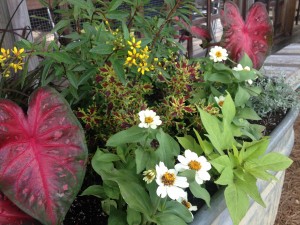 Since it is a restaurant, after all, and ornamental peppers were plentiful in the nursery, those were placed next, just in front of red Dragonwing begonias. Eventually the peppers might be enveloped by the other plants, but until then they’ll contribute their small white flowers and ornamental purple peppers to the mix,
Since it is a restaurant, after all, and ornamental peppers were plentiful in the nursery, those were placed next, just in front of red Dragonwing begonias. Eventually the peppers might be enveloped by the other plants, but until then they’ll contribute their small white flowers and ornamental purple peppers to the mix,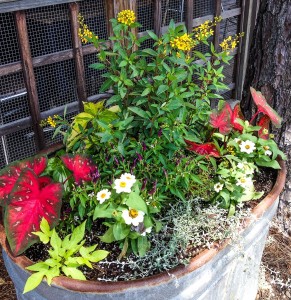 Last, a silver trailing plant. Usually I use silver dichondra for this color because it holds up extremely well in our heat and humidity where so many other silver plants fail. This year, though, I’ve decided to try a new plant…a selection of one that I haven’t had good luck with, but this is supposed to be an improved variety, so we’ll see. It’s a licorice vine, Helichrysum ‘Silver Star’. We’ll keep an eye on this one and hope for the best. It scored high marks in the University of Georgia Athens trial gardens, so I have high hopes!
Last, a silver trailing plant. Usually I use silver dichondra for this color because it holds up extremely well in our heat and humidity where so many other silver plants fail. This year, though, I’ve decided to try a new plant…a selection of one that I haven’t had good luck with, but this is supposed to be an improved variety, so we’ll see. It’s a licorice vine, Helichrysum ‘Silver Star’. We’ll keep an eye on this one and hope for the best. It scored high marks in the University of Georgia Athens trial gardens, so I have high hopes!
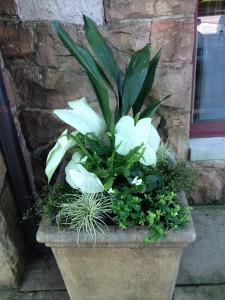 A testament to its common name of cast iron plant, the aspidistra looked amazingly good considering the bone-chilling temperatures Birmingham dipped to in January. It only needed a few leaves cut out, and no thinning was required this season…probably due to the cold. A heuchera, that had been added in the
A testament to its common name of cast iron plant, the aspidistra looked amazingly good considering the bone-chilling temperatures Birmingham dipped to in January. It only needed a few leaves cut out, and no thinning was required this season…probably due to the cold. A heuchera, that had been added in the  Torenia is an interesting plant, useful in
Torenia is an interesting plant, useful in 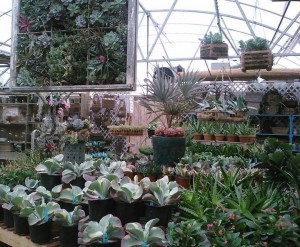
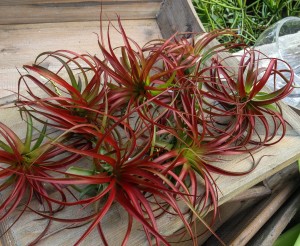

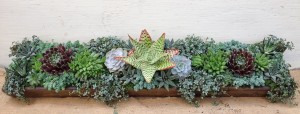 Because succulents, air plants and even
Because succulents, air plants and even 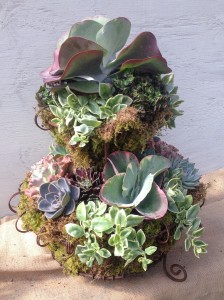
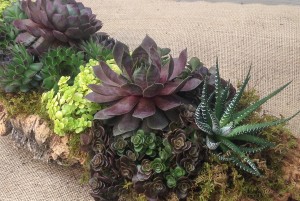
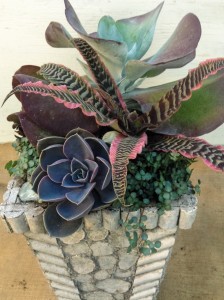
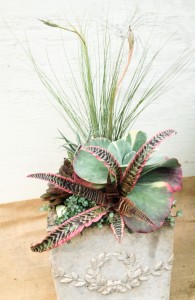
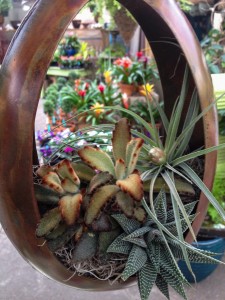
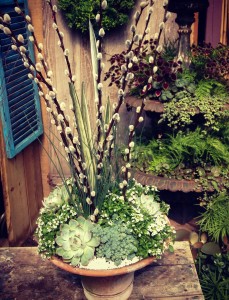
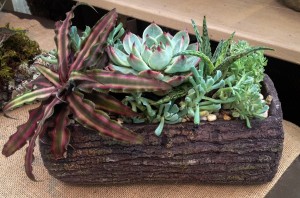
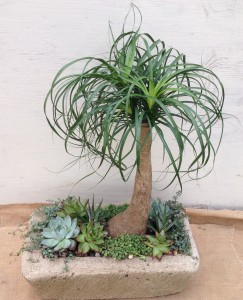

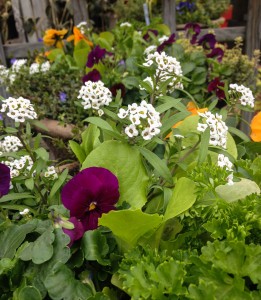
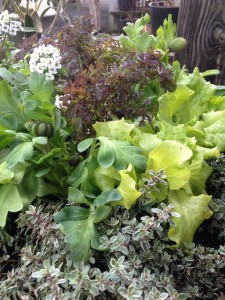
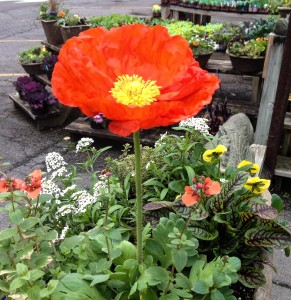

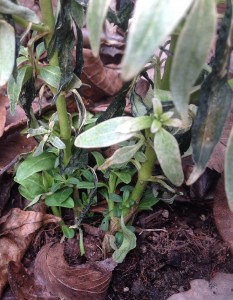

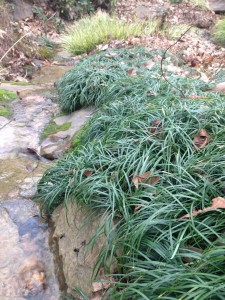
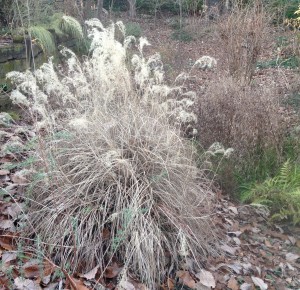
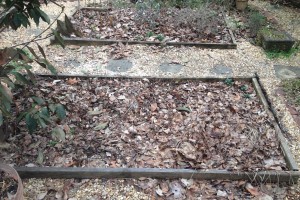
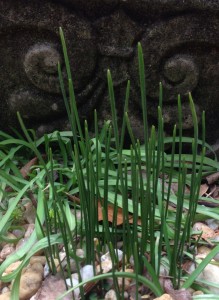
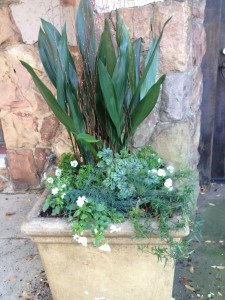
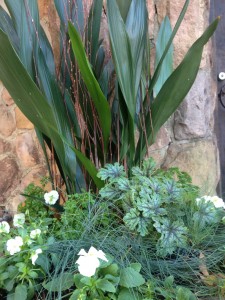 The emphasis is on foliage, though, and I’ve included curly parsley for it’s fresh green color, a small blue fescue grass, and a shade loving heuchera for this planting. Holdovers from the summer are aspidistra, which I thin out each season, and a tiny leaf green ivy. After planting, I added birch branches to add more height and winter interest. (Branches are an easy way to get color in planters during the holiday – red twig dogwood branches would also be pretty.) While it looks a bit top heavy with the tall aspidistra at first, the parsley and heuchera will add fullness to the composition as it grows in. I’m also trying the Cool Wave white trailing pansies here this year, hoping they get enough sun to bloom well.
The emphasis is on foliage, though, and I’ve included curly parsley for it’s fresh green color, a small blue fescue grass, and a shade loving heuchera for this planting. Holdovers from the summer are aspidistra, which I thin out each season, and a tiny leaf green ivy. After planting, I added birch branches to add more height and winter interest. (Branches are an easy way to get color in planters during the holiday – red twig dogwood branches would also be pretty.) While it looks a bit top heavy with the tall aspidistra at first, the parsley and heuchera will add fullness to the composition as it grows in. I’m also trying the Cool Wave white trailing pansies here this year, hoping they get enough sun to bloom well.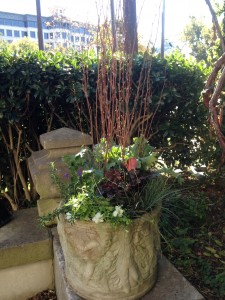
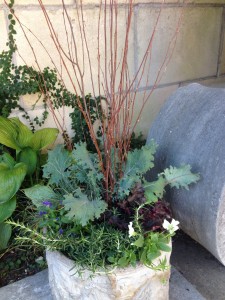 This fall Pardis asked if I would also take a look at the planters at Bottega, their other wonderful restaurant.
This fall Pardis asked if I would also take a look at the planters at Bottega, their other wonderful restaurant.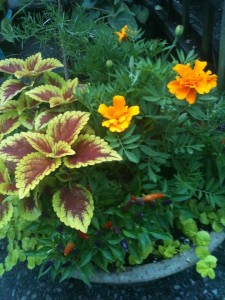 I’m not quite sure I’ve been living in the Southeast this summer…plentiful rain and decent temperatures – (Though it looks like the heat is finally returning.) this has been Alabama in August?!
I’m not quite sure I’ve been living in the Southeast this summer…plentiful rain and decent temperatures – (Though it looks like the heat is finally returning.) this has been Alabama in August?!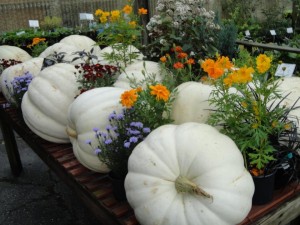
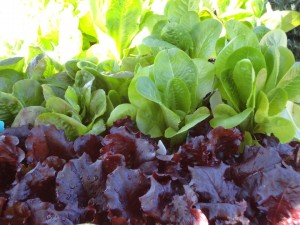 But, if your garden and beds are struggling…think about where you’d like to see marigolds, ornamental peppers, late season salvias, and, further down the road, lettuce, asters and cool season herbs – we’ll have transplants of parsley, thyme (Look for the lemon variegated thyme which looks beautiful with green or red lettuce and marigolds.) dill and cilantro too.
But, if your garden and beds are struggling…think about where you’d like to see marigolds, ornamental peppers, late season salvias, and, further down the road, lettuce, asters and cool season herbs – we’ll have transplants of parsley, thyme (Look for the lemon variegated thyme which looks beautiful with green or red lettuce and marigolds.) dill and cilantro too.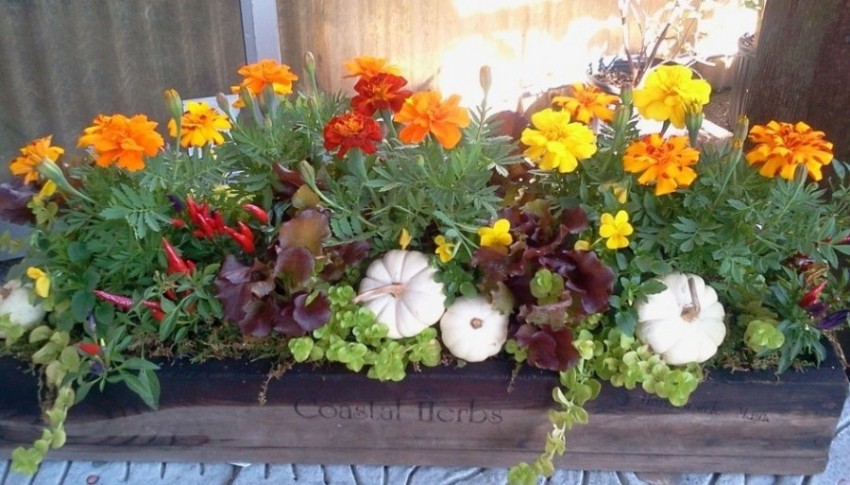
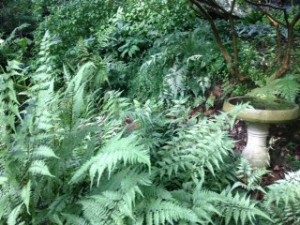 With 2013 beginning with a wet, cool spring and the rain continuing into early summer, it seemed like we’d been transported into a different universe than Alabama, didn’t it? All the rain may have caused some complacency – everything seems so much lusher than it usually is this time of year…now the heat is here, though, and it seems certain we’ll be entering our usual summer pattern of hit and miss rain showers with lots of warmth and humidity…
With 2013 beginning with a wet, cool spring and the rain continuing into early summer, it seemed like we’d been transported into a different universe than Alabama, didn’t it? All the rain may have caused some complacency – everything seems so much lusher than it usually is this time of year…now the heat is here, though, and it seems certain we’ll be entering our usual summer pattern of hit and miss rain showers with lots of warmth and humidity…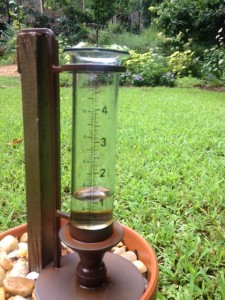 Established plantings in your landscape should be doing well, but be aware that new plantings of shrubs, trees and perennials will need supplemental watering this first summer – pay attention to them. The requirement for new plantings is an inch of water each week.
Established plantings in your landscape should be doing well, but be aware that new plantings of shrubs, trees and perennials will need supplemental watering this first summer – pay attention to them. The requirement for new plantings is an inch of water each week.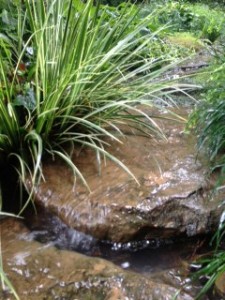

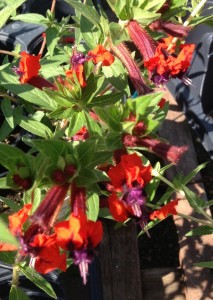
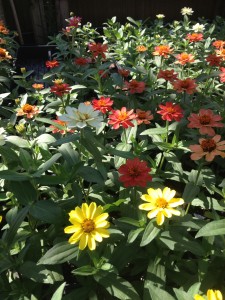
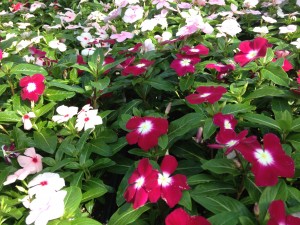
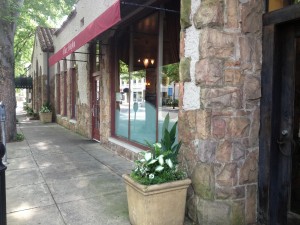 Owners Frank and Pardis Stitt prefer white and green for the front of this French cafe, located next to their acclaimed restaurant Highlands in downtown Birmingham. These are fairly large, tan colored cast stone planters with nice clean lines. A mix of contrasting green and variegated foliage with a touch of white add light to this shady spot, and the stone wall adds a pleasing backdrop to the planting.
Owners Frank and Pardis Stitt prefer white and green for the front of this French cafe, located next to their acclaimed restaurant Highlands in downtown Birmingham. These are fairly large, tan colored cast stone planters with nice clean lines. A mix of contrasting green and variegated foliage with a touch of white add light to this shady spot, and the stone wall adds a pleasing backdrop to the planting.